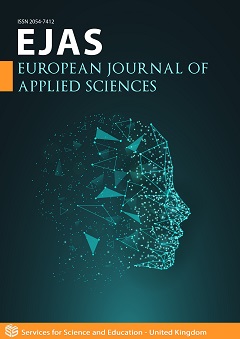Optimal Control of Fish Growth Under Uncertainty Using Chance Constraint Model Predictive Controller
DOI:
https://doi.org/10.14738/aivp.105.13214Abstract
To achieve sustainability goals (social, economic and environmental), recirculation aquaculture systems (RAS) should be operated at optimal conditions. Recirculation aquaculture systems have various additive and unpredictable disturbances such as irregular temperature in big tanks, uneven distribution of feed and uncertain rate constants for nutrients utilization by fish. With such disturbance the performance of RAS cannot be met with probability one. Thus, the performance level should be attained under a desired probability (reliability) level. Therefore, in this paper we apply the chance-constraint model predictive control (CC-MPC) approach with state estimation using an Unscented Kalman Filter (UKF) to meet this requirement. The cost function is based on the feed conversion ratio metric, profit maximization with desired growth reference trajectory tracking. A bio-energetic and econometric model of fish growth in a RAS is utilized to illustrate the application of the formulation through simulations. Healthy fish growth is enabled by applying a health monitoring estimator based on artificial Intelligence (AI) in the feedback loop. The CC-MPC is compared to a deterministic MPC, with a focus on constraint breaching, computation time, and operational behavior. The simulations show similar performance for the fish growth for both types of MPC, while the computation time increases slightly for the CC-MPC, together with operational behaviors getting limited. In the case study, a final average fish weight of 433g is reached at a reliability level of 95% compared to 429g of the deterministic approach.
References
. FAO, The state of world fisheries and aquaculture, Meeting the Sustainable Development Goals, Licence CC BY–NC–SA 3.0 IGO, Rome (2018)
. Frank Asche, Ruth Beatriz Mezzalira Pincinato, Ragnar Tveteras Productivity in Global Aquaculture, (Jun 2022): 1525–1561. https://doi.org/10.1007/978-981-10-3455-8_41
. Trond Bjørndal, Amalie Tusvik Economic analysis of on-growing of salmon post-smolts, Aquaculture Economics & Management 24, no.44 (Mar 2020): 355–386., https://doi.org/10.1080/13657305.2020.1737272
. Kazmierczak F.R., Rex Caffey H., Management ability and the economics of recirculating aquaculture production systems, Mar. Resour. Econ., 10 (2) (1995), pp. 187-209
. Karimanzira D., Keesman K., Kloas W., Baganz D., Rauschenbach T. (2017) Efficient and economical way of operating a recirculation aquaculture system in an aquaponics farm Aquaculture Economics and Management, 21 (4) , pp. 470-486.
. Chahid, A., Ibrahima N’Doye, John E. Majoris, Michael L. Berumen, Taous Meriem Laleg-Kirati, (2021) Model predictive control paradigms for fish growth reference tracking in precision aquaculture, Journal of Process Control, Volume 105, 2021, Pages 160-168, ISSN 0959-1524, https://doi.org/10.1016/j.jprocont.2021.07.015.
. Venolia C.-T., Lavaud R., Green-Gavrielidis L.A., Thornber C., Humphries A.T., Modeling the growth of sugar kelp (Saccharina latissima) in aquaculture systems using dynamic energy budget theory Ecol. Model., 430 (2020), Article 109151
. Atoum Y., Srivastava S., Liu X. Automatic feeding control for dense aquaculture fish tanks, IEEE Signal Process. Lett., 22 (2015), pp. 1089-1093
. Oostlander P., Van Houckeb J., Wijffels R., Barbosaa M., Microalgae production cost in aquaculture hatcheries, Aquaculture, 525 (2020), Article 735310
. Grosso JM, Ocampo-Martinez C, Puig V, Joseph-Duran B. Chance-constrained model predictive control for drinkingwaternetworks.Journal of Process Control2014; 24: 504-516.
. Chahid, A., N'Doye, I., Majoris, J. E., Berumen, M. L., & Laleg-Kirati, T.-M. (2022). Fish growth trajectory tracking using Q-learning in precision aquaculture. Aquaculture, 550, 737838. doi: 10.1016/j.aquaculture.2021.737838
. Trond BjØrndal (2022), Optimal Harvesting of Farmed Fish, Marine Resource Economics Volume 5, Number 21988, DOI: https://doi.org/10.1086/mre.5.2.42628926
. Mistiaen J.A., Strand I. Optimal feeding and harvest time for fish with weight-dependent prices, Mar. Resour. Econ., 13 (1998), pp. 231-246
. Zhao, S., Zhu, M., Ding, W., Zhao, S., & Gu, J. (2020). Feed requirement determination of grass carp (Ctenopharyngodon idella) using a hybrid method of bioenergetics factorial model and fuzzy logic control technology under outdoor pond culturing systems. Aquaculture, 521, 734970. doi: 10.1016/j.aquaculture.2020.734970
. A. Geletu, A. Hoffmann, P. Schmidt, P. Li: Chance constrained optimization of elliptic PDE systems with smoothing approximations. ESAIM: COCV, 26(2020)70. Published online: 30 September 2020. DOI:10.1051/cocv/2019077).
. S. Papp, K Gyorgy, A. Kelemen and L. Jakab-Farkas, “Applying the Extended and Unscented Kalman Filters for Nonlinear State Estimation,” Inter-Eng 2012 Conference Proceedings, Tg Mures ., pp. 233-239, 2012.
. S. M. Chow, E. Ferrer and J. R. Nesselroade, “An Unscented Kalman Filter Approach to the Estimation of Nonlinear Dynamical Systems Models,” Multivariate Behavioral Research .., vol. 42, no. 2, pp. 283-321, Dec. 2007.
. Ursin E. A mathematical model of some aspects of fish growth, respiration, and mortality, J. Fish. Res. Board Can., 24 (1967), pp. 2355-2453
. Karimanzira D., Keesman K.J., Kloas W., Baganz D., Rauschenbach T. Dynamic modeling of the INAPRO aquaponic system, Aquacult. Eng., 75 (2016), pp. 29-45, 10.1016/j.aquaeng.2016.10.004
. Nemirovski, A.andH. M. Stewart(2012) “On Safe Tractable Approxi-mations of Chance Constraints,”Eur. J. Oper. Res., (219), pp. 707–718.
. Nemirovski, A.andA. Shapiro(2005) “Scenario Approximations ofChance Constraints,”Probabilistic and Randomized Methods for Design un-der Uncertainty, Springer, pp. 3–47.
. Tempo, R.,G. Calafiore, andF. Dabbene(2013)Randomized Algorithmsfor Analysis and Control of Uncertain Systems, Communications and Control Engineering, Springer London, London
. Wächter, Andreas; Biegler, Lorenz T. (2006). "On the implementation of an interior-point filter line-search algorithm for large-scale nonlinear programming" (PDF). Mathematical Programming. 106: 25–57. doi:10.1007/s10107-004-0559-y. S2CID 14183894
Downloads
Published
How to Cite
Issue
Section
License
Copyright (c) 2022 Divas Karimanzira, Thomas Rauschenbach

This work is licensed under a Creative Commons Attribution 4.0 International License.






